
Stylophora pistillata, commonly known as hood coral or smooth cauliflower coral, is a species of stony coral in the family Pocilloporidae. It is native to the Indo-Pacific region and is commonly used in scientific investigations.
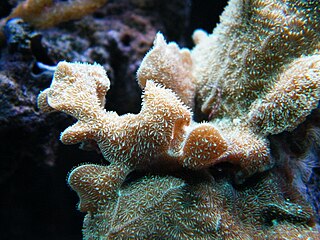
Pavona cactus, the cactus coral, potato chip coral or leaf coral, is a species of colonial stony coral in the family Agariciidae. This coral is found in shallow waters on reefs and in lagoons in tropical parts of the Indo-Pacific region.

Diploastrea heliopora, commonly known as diploastrea brain coral or honeycomb coral among other vernacular names, is a species of hard coral in the family Diploastreidae. It is the only extant species in its genus. This species can form massive dome-shaped colonies of great size.

Alveopora spongiosa is a species of stony coral that is found in the Red Sea, the Gulf of Aden, the southwest and northern Indian Ocean, the central Indo-Pacific, Australia, Southeast Asia Japan, the East China Sea and the oceanic west and central Pacific Ocean. It can be found on protected upper coral reef slopes, generally from depth of 9–20 m, but can grow at depths of up to 50 m. It is moderately susceptible to coral bleaching, and is harvested for the aquarium trade.
Alveopora verrilliana is a species of stony coral that is found in the Red Sea, the Gulf of Aden, the northern Indian Ocean, the central Indo-Pacific, Australia, Southeast Asia, Japan, the East China Sea, the oceanic west and central Pacific Ocean and the Johnston Atoll. It can also be found in Palau and the southern Mariana Islands. It grows on shallow coral reefs to a depth of 30 metres (100 ft). It is particularly susceptible to coral bleaching and is harvested for the aquarium trade.

Turbinaria stellulata, also known as disc coral, is a species of colonial stony coral in the family Dendrophylliidae. It is native to the Indo-Pacific region. The International Union for Conservation of Nature has rated its conservation status as being "vulnerable".

Turbinaria mesenterina, commonly known as disc coral, is a species of colonial stony coral in the family Dendrophylliidae. It is native to the Indo-Pacific region. The International Union for Conservation of Nature has rated its conservation status as being "vulnerable".

Turbinaria peltata, commonly known as disc coral, is a species of colonial stony coral in the family Dendrophylliidae. It is native to the Indo-Pacific region. The International Union for Conservation of Nature has rated its conservation status as being "vulnerable".
Turbinaria frondens, commonly known as disc coral, is a species of colonial stony coral in the family Dendrophylliidae. It is native to the Indo-Pacific region. It is a zooxanthellate coral that houses symbiont dinoflagellates in its tissues.
Turbinaria patula, commonly known as disc coral, is a species of colonial stony coral in the family Dendrophylliidae. It is native to the Indo-Pacific region, being found in the eastern Indian Ocean, northern Australia, the South China Sea and the western Pacific Ocean. It is a zooxanthellate coral that houses symbiont dinoflagellates in its tissues. It is an uncommon species and the International Union for Conservation of Nature (IUCN) has rated it as a "vulnerable" species.

Favites pentagona is a species of stony coral in the family Merulinidae, sometimes known as larger star coral. It is native to the Indo-Pacific region and its range extends from the Red Sea through the Indian Ocean to the Western Pacific Ocean. This is a common species throughout its wide range and the International Union for Conservation of Nature has rated its conservation status as being of "least concern".
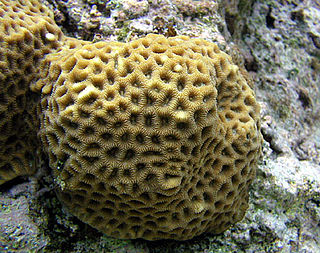
Favites abdita, also known as the larger star coral, is a species of stony coral in the family Merulinidae. It is native to the Indo-Pacific region and its range extends from East Africa and the Red Sea through the Indian Ocean to the Western Pacific Ocean. The International Union for Conservation of Nature has rated its conservation status as being "near-threatened".

Seriatopora caliendrum is a species of colonial stony coral in the family Pocilloporidae. It forms a bushy clump and is commonly known as the green birdsnest coral. It is native to East Africa, the Red Sea and the western Indo-Pacific region, the type locality being the Red Sea. It grows in shallow water on reef slopes, particularly back-reef slopes, at depths down to about 25 metres (82 ft). The International Union for Conservation of Nature has assessed the conservation status of this species as being "near threatened".

Favites complanata is a species of stony coral in the family Merulinidae, sometimes known as the larger star coral. It is native to the Indo-Pacific region and its range extends from the Red Sea and Indian Ocean to the western and central Pacific Ocean. This is an uncommon species of coral and seems to be decreasing in abundance, and the International Union for Conservation of Nature has rated its conservation status as being "near threatened".

Platygyra lamellina, the hard brain coral, is a species of colonial stony coral in the family Merulinidae. It occurs on reefs in shallow water in the Indo-Pacific region. The International Union for Conservation of Nature has assessed its conservation status as being "near threatened".

Oulophyllia crispa, sometimes called the intermediate valley coral, is a species of stony coral in the family Merulinidae. It is native to the tropical western and central Indo-Pacific region. Although this coral has a wide range, it is generally uncommon and seems to be decreasing in abundance, and the International Union for Conservation of Nature has rated its conservation status as being "near threatened".
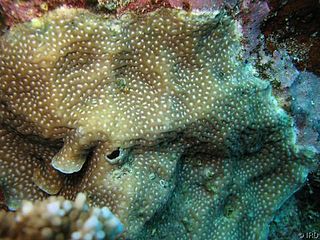
Pavona bipartita, sometimes known as leaf coral, is a species of colonial stony coral in the family Agariciidae. It is found in shallow water, on reef slopes and on vertical surfaces, in tropical parts of the western and central Indo-Pacific region.

Blastomussa merleti, commonly known as pineapple coral, is a species of large polyp stony coral. It is unclear in which family the genus Blastomussa belongs. This coral is native to the west and central Indo-Pacific region and is sometimes used in reef aquaria.
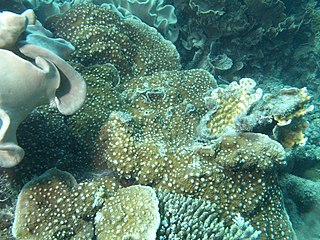
Oxypora lacera, the ragged chalice coral or porous lettuce coral, is a species of large polyp stony corals in the family Lobophylliidae. It is a colonial coral which can be submassive, encrusting or laminar. It is native to the western Indo-Pacific.
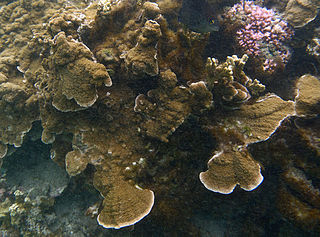
Echinophyllia aspera, commonly known as the chalice coral, is a species of large polyp stony corals in the family Lobophylliidae. It is a colonial coral which is partly encrusting and partly forms laminate plates or tiers. It is native to the western and central Indo-Pacific.


















